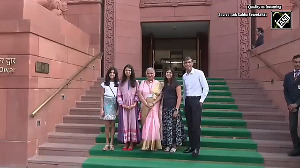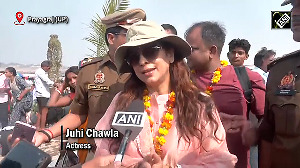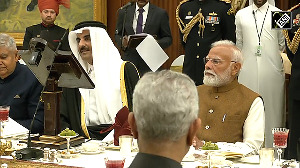Jayapur, adopted by the prime minister, is reaping the benefits of his endorsement, causing resentment in villages nearby, says Manavi Kapur.

One year ago, a high tension electrical line fell in Jayapur village in Uttar Pradesh, causing serious injuries to four people.
This was the time when Narendra Modi was campaigning in Varanasi, under which Jayapur falls. Narayan Patel, the “leader” of the village, got a call on his mobile phone from Modi, enquiring whether any representative of the government had visited the village to take stock.
None had.
According to Patel, Modi then took to Twitter, his pet social media platform, to express his concern.
Once he became the prime minister, Modi “adopted” Jayapur under the Sansad Adarsh Gram Yojana. A year later, the mishap has proved a boon for the fortunes of the 4,200 residents of Jayapur.
A mere 25 kilometres from Varanasi, Jayapur has become a metaphor for model village development after Modi’s endorsement.
A concrete gate announces the village limits.
Police vehicles are parked towards the left of the entrance, surrounding a massive tented area.
A policeman explains that Uttar Pradesh Governor Ram Naik will be here to attend a “function”.
Inside the enclosure, red upholstered chairs are neatly lined facing an elevated dais. Though the event is to begin at 7 pm and it is only noon, Patel, wearing a khadi kurta-pyjama and a saffron scarf, is parked on the dais, to see as much as to be seen.
“I was campaigning for the Bharatiya Janata Party in Jayapur last year with Sunil Ojha, Sunil Devdar and Manohar Lal Khattar (now Haryana chief minister) for Modiji,” says Patel, eagerly dropping names with a diction hampered by the paan he is chewing. “After Modiji won, I wrote to him about adopting our village.”
Success, of course, has many claimants.
With bloodshot, bespectacled eyes, Patel scans the venue for the preparations, and any VIP movement.
The event, according to a pamphlet he shows me, is a religious one, arranged by Radhika Creations, a Nagpur-based theatre group that has performed dramas on Swami Vivekananda, one of Rashtriya Swayamsevak Sangh’s chosen leaders.
Right then, a young woman walks into the enclosure and policemen rush to their feet. Patel glances at her over his shoulder and adds, almost dismissively, “She is the sub-divisional magistrate.”
Modi’s point man has nothing and no one to fear.
Driving into the village, solar street lights make their appearance at short distances from each other, standing like anomalies amid the golden wheat fields, much like a government advertisement for development.
After every 100 metres or so, a red park bench is placed on the side of the street.
These bear Modi’s name in Hindi with slogans from his pet projects: Swachh Bharat and Beti Bachao, Beti Padhao.
Unlike villages in Haryana and Rajasthan, a car is a rare sight in Jayapur, and each person sitting on one of these benches perks up at the sight of a car to see if an influential politician is visiting the village.
Development may have come here, but prosperity is still some distance away.
“We are very happy,” says Jayapur resident Rabindra Kumar defensively, before I can even ask the question.
“We have toilets and solar lights. What more can we ask for?”
When I ask him how and when a toilet was installed at his home, he hesitates before saying, “But our home has had a toilet for the last few years now.”
Jayapur had been on the path of becoming adarsh before Modi.
Kumar’s mother, Dhanisra Devi, is pleased with what Modi has accomplished, but wants more.
“The most important thing is employment,” she rues.
Though it is the middle of the day at the start of the week, most male members of the family are at home.
When I ask Radheyshyam, a teacher in a private school, if he knows the blueprint for this development, he says that only Patel would be able to share those details, though he will be at the “function”.
But does he know what this event is?
“They must be inaugurating those 14 houses that have been built for vanwaasis,” he says, trying to veil his unhappiness about sharing the progress pie with “outsiders”.
Dhanisra Devi pipes in: “They have full VIP facilities, including a garden in front of their homes.”
When I ask who these vanwaasisare, a child whispers the word Dalit. Development hasn’t erased the caste tensions here.
Two kilometres away, these white-and-blue houses shine bright in the afternoon sun.
Masons lay bricks to create a gate for the settlement.
A small flowerbed has seasonal blooms and shoots of grass have begun to cover the soil.
Manni is sweeping the floor in front of her brick home, right next to the newly constructed flat that will soon be hers.
She takes me on a tour of the house. A blue-painted iron gate opens into a verandah.
The toilet, bathroom and kitchen are to the right, in one row, with a 36 square feet room at the end.
She and her husband own no land and therefore now work as contract labour at construction sites.
Naturally, they are grateful to Modi for this house.
“The Thakurs (the landowners) have made our lives miserable. Had it not been for Modi, we would never have seen this development,” says her mother-in-law.
None of the families for whom these homes are being built knows anything about the property papers or ownership details.
Progress comes to them without their knowledge, choice or participation.
“We only got to know about these homes once they began construction,” says Manni.
The contractor for this project, Dayanand Mani Tripathi of Delhi-based Anna Associates, explains that these houses are being constructed since December 2014 by Allanasons, a Maharashtra company that exports processed foods.
“In a way, the company has adopted this part of the village on its own, particularly because the poorest of the poor reside here,” he says.
This is true for most solar lights and bio-toilets, too, I later find out.
Some solar lights have been installed by Union Bank, while others have come from Surat-based Goldi Green, a green-infra company.
Corporate chieftains, including those from the public sector, know how to be in the good books of Modi.
Modi himself has spent only Rs 40 lakh from the Rs 5 crore allocated under the Member of Parliament Local Area Development Scheme, but his endorsement has been investment enough, so far.
A bench almost poetically reads “sabka saath, sabka vikas” -- Modi’s mantra for inclusive development.
Patel’s own family lives under his flamboyant persona. Seated on a plastic chair in a large courtyard, Durgawati Devi is the sarpanch of Jayapur.
She took over as the village head after her husband died, though her representative and brother-in-law, Patel, is the face of the village.
“Eighty-seven per cent of our village voted for Modi,” she says with a smile.
When asked about the communities that live in the village, she says without hesitation, “All of us are Hindus here. You’ll find the Muslim community in neighbouring Chandapur village.”
Chandapur could well be the twin of Jayapur, with perhaps better roads.
The village, also in Modi’s Lok Sabha constituency, comes under the Lohiya Grameen Awaas Yojana, a village development scheme run by the Samajwadi Party government in the state. But its impact is lesser.
“Our village is untouchable, not because of our caste but because we have no share in the development,” says Joginder Pal of Chandapur.
With his wife and daughter-in-law, Pal sits on a charpoy, looking with empty eyes at the cattle in his front yard.
“We too voted for Modi, but we have not benefited from it so far,” he says. His home has no toilet and they rely on natural light during the day to get work done.
His wife, Pal says, needs a new heart valve and asks if I’ll help him reach Modi.
“Will you publish our conversation and take our voice to him?” Delhi, it appears, is too far for him.
Despite being despondent about his circumstances, when I ask him about the Muslim community in his village, he assumes an air of superiority.
“You’ll find them where this road ends.”
After driving two kilometres on a winding road, I begin to see Pal’s meaning. The pucca roads give way to lanes rendered slushy by the rains: development will only go so far.
“We are a community of weavers and we never went out to look for work. But things have changed and we have no employment,” says Mohammad Yasin, the imam of the Chandapur mosque.
The community now relies on farming for income, though Yasin says that they have recently received the bunkar card meant to certify weavers and offer them employment.
“We asked the pradhan of Jayapur to share this development with us, but all we have got are stray drops from the rain of benefits,” he says with a sense of resignation.
“Electrical wires fall here too, but perhaps some wires are luckier than the others.”








 © 2025
© 2025